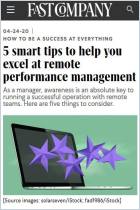
This Five Step Management Plan Will Help a Remote Employee Who Consistently Fails to Perform
While it would be ideal if employee performance was never an issue, understanding the options enables managers to succeed when it is.
Recommendation
Writing for Fast Company, management educators Susan Vroman and Barbara Larson outline five steps for dealing with unproductive staff working remotely. While your employees are working virtually during the pandemic, you may need to adjust your management style. Start with knowing your current performance policies and metrics, and evaluate team members based on their individual results. If someone is faltering, define your expectations and, if necessary, create improvement plans with a set timeline. Your last option after that may prove the most difficult: Fire staff members who aren’t fulfilling their job requirements. If you don’t, you risk the ire of more-productive team members.
Summary
About the Authors
Bentley University management lecturer Susan Vroman is a leadership consultant. Co-author Barbara Larson is a management executive professor at Northeastern University.


















Comment on this summary or Comenzar discusión